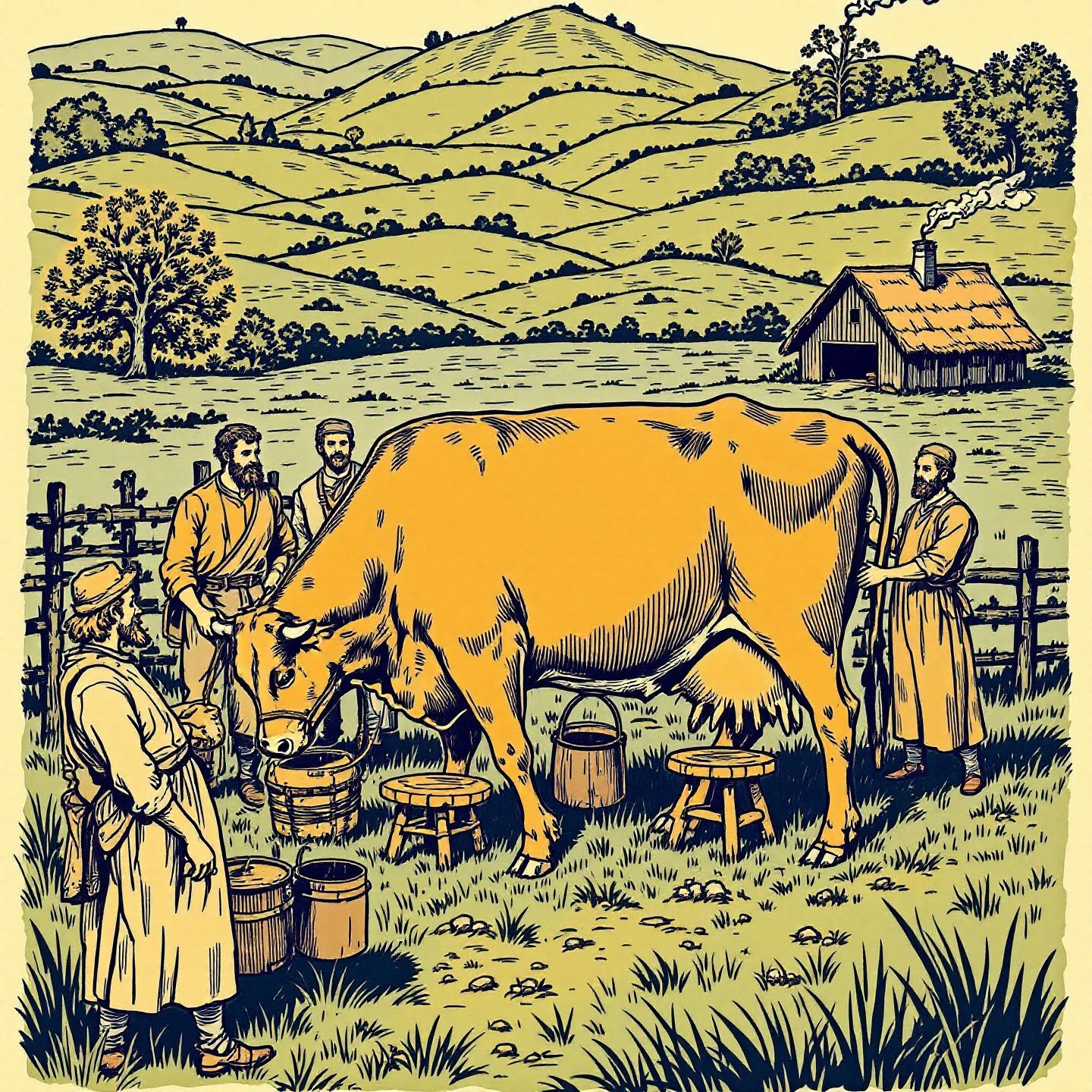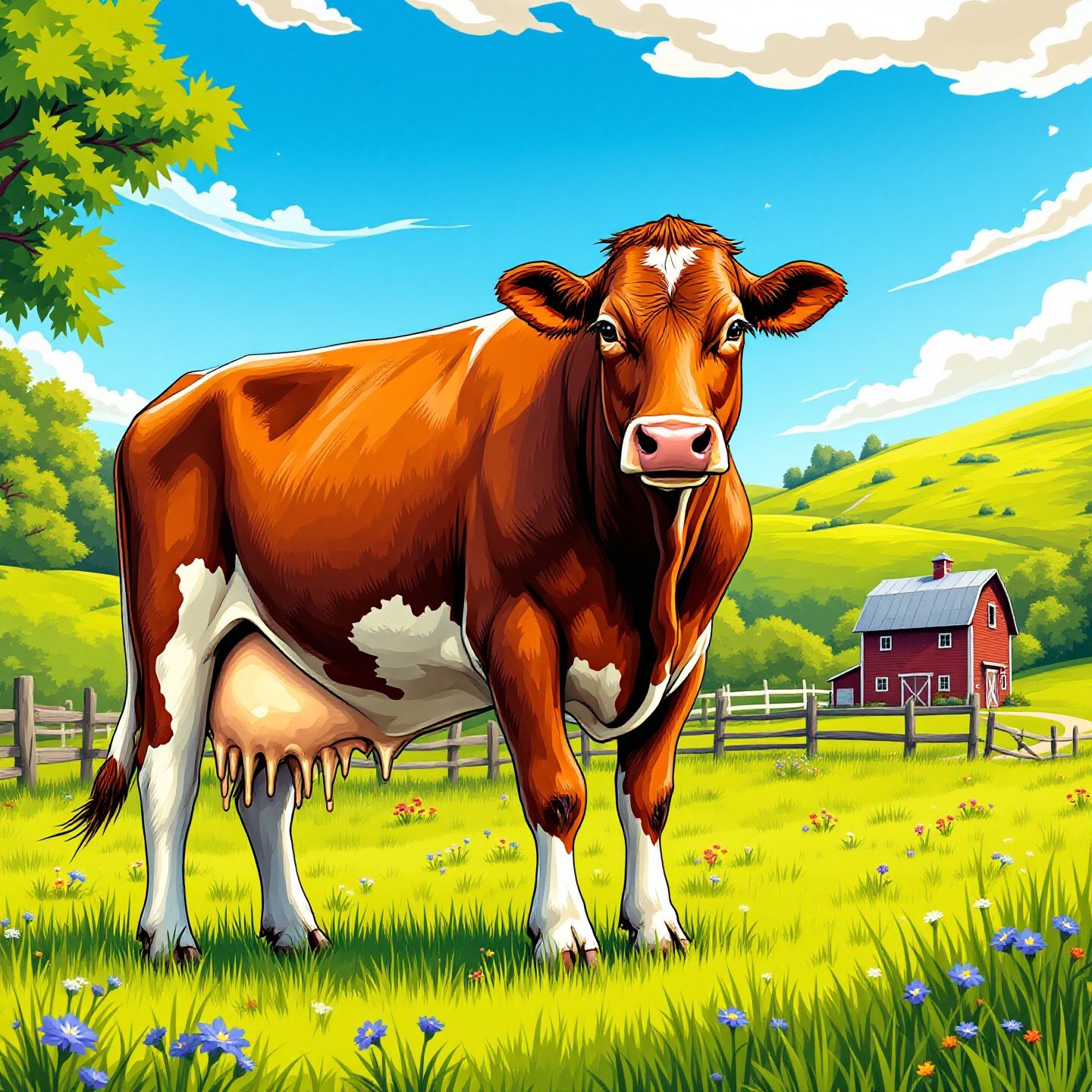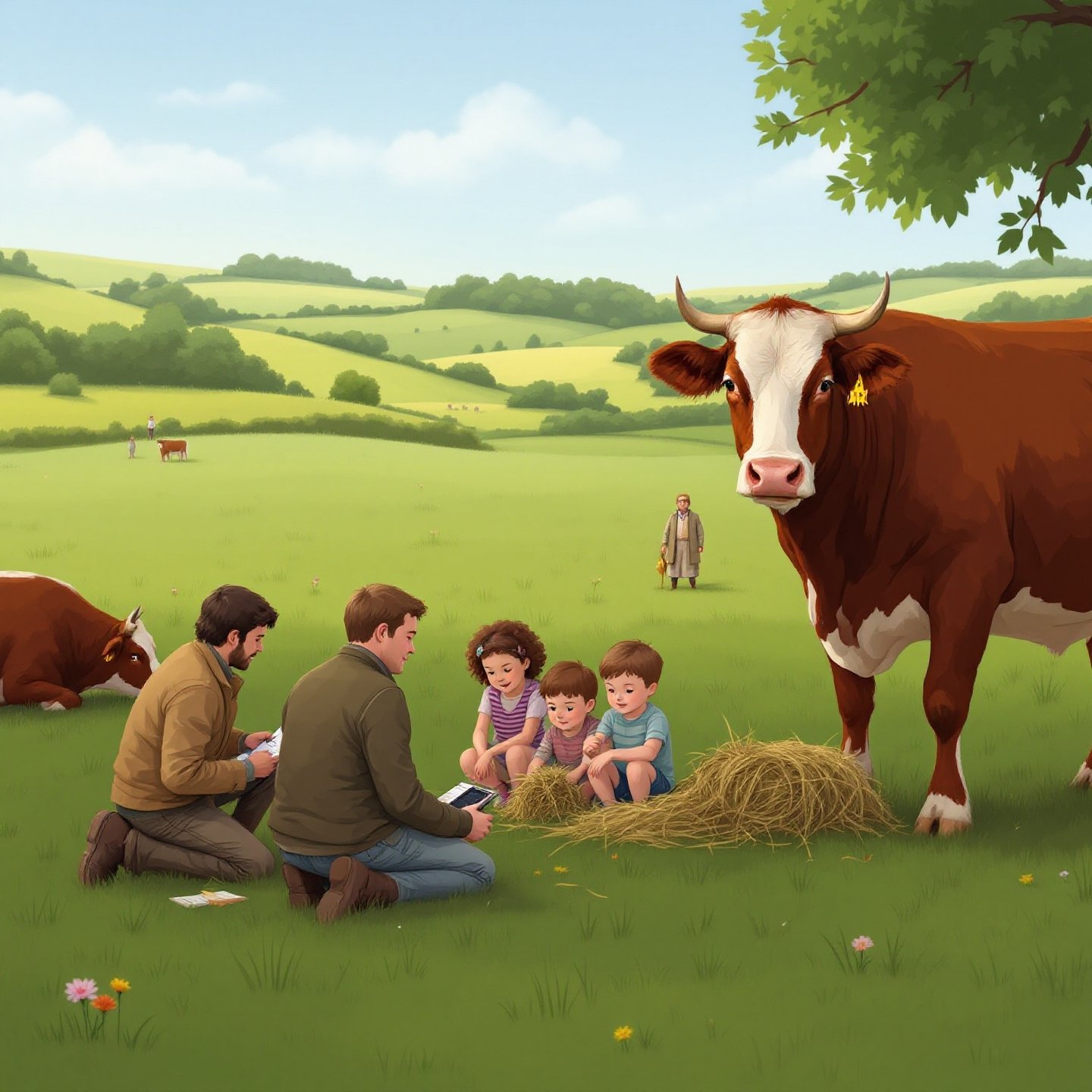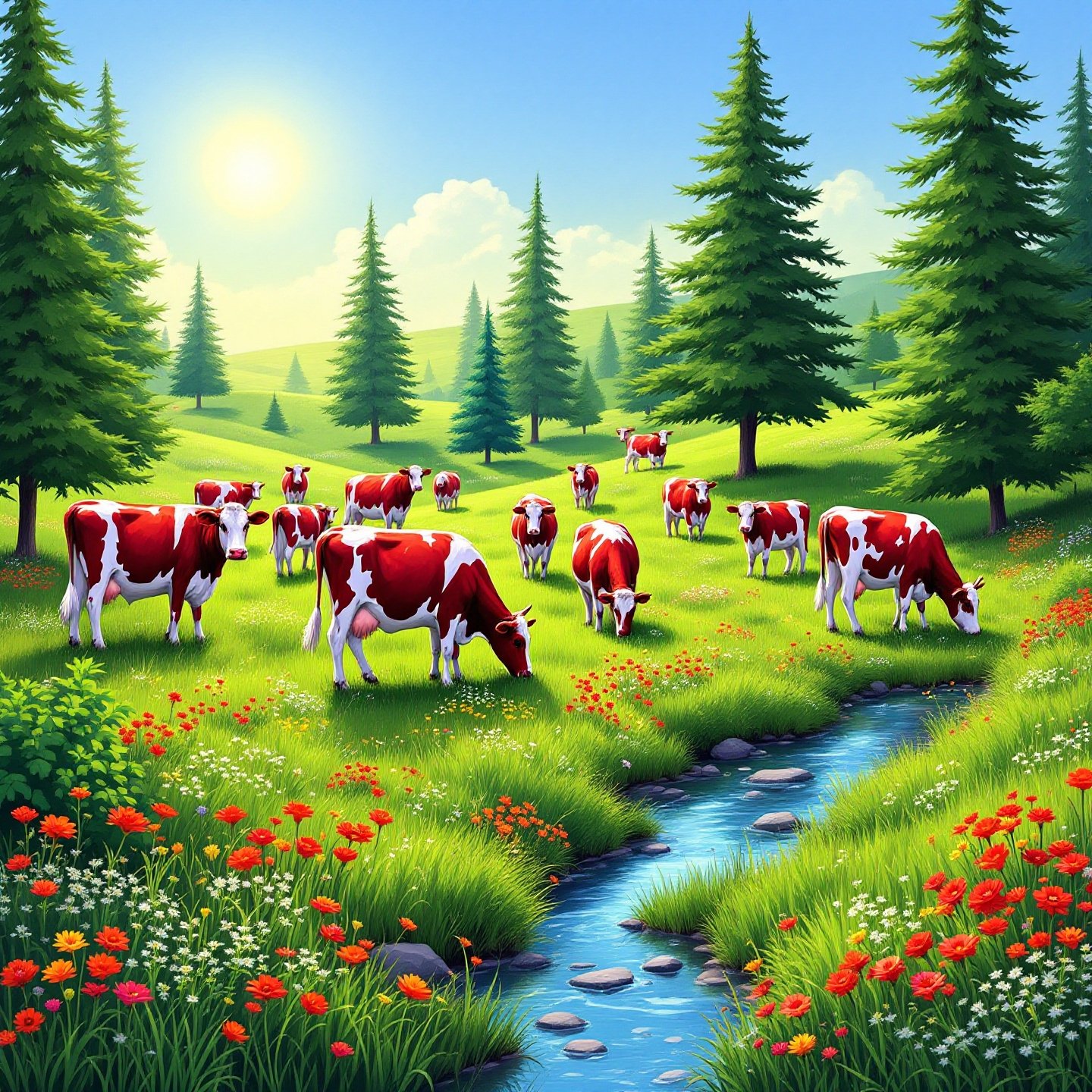Introduction to Milking Devon’s Rank in Milk Production
The American Milking Devon is a breed with a rich history and unique place in the world of dairy production. Known for its dual-purpose capabilities, this breed offers both milk and beef, making it a versatile choice for farmers who value efficiency and sustainability. Originating from the North Devon cattle of England, the Milking Devon was first introduced to America in the early 17th century, specifically in 1624, when three heifers and a bull were brought to the Plymouth Colony. This introduction marked the beginning of a breed that would become integral to early American agriculture, valued for its strength, intelligence, and adaptability to various climates and terrains.
Despite its historical significance, the American Milking Devon is not primarily ranked among the top dairy producers when measured against specialized dairy breeds like the Holstein or Jersey. This breed’s milk production is more modest, with an annual yield that meets the needs of small-scale and sustainable farming operations rather than large commercial dairies. The Milking Devon’s milk is rich in quality, with a notable butterfat content that enhances its appeal for cheese and cream production. This characteristic aligns with the breed’s historical use, where its milk was prized for such purposes.
Today, the American Milking Devon is considered a conservation priority, listed as ‘critical’ by the Livestock Conservancy. This status underscores the importance of preserving this breed, not only for its cultural heritage but also for its role in sustainable agriculture. The Milking Devon’s ability to thrive on low-quality forage and its suitability for organic farming practices make it a valuable asset in efforts to promote biodiversity and resilience in farming systems. As farmers and conservationists work to maintain its population, the Milking Devon continues to be a symbol of agricultural history and a potential solution for future farming challenges.

Historical Background of Milking Devon Cattle
The journey of the Milking Devon breed is a fascinating tale of adaptation and resilience. Originating from Devonshire, England, these cattle were initially introduced to America in 1623, marking the beginning of their significant role in early American agriculture. Known for their deep red coats and blond-tipped tails, the American Milking Devon was among the first cattle breeds to set hoof on New World soil, brought by settlers who valued their versatility. These cattle were not only prized for their milk and beef but also for their strength and intelligence, making them ideal for draft work such as plowing fields and pulling carts.
In the 17th and 18th centuries, the Milking Devon was a staple in the colonies, particularly in New England, where their ability to thrive on rough forage and work on hilly terrain made them indispensable. As the breed spread down the East Coast, their utility in providing milk, meat, and labor cemented their place in the agricultural landscape. However, by the late 19th century, the rise of more specialized breeds like the Shorthorn began to overshadow the Milking Devon. This shift led to a decline in their population, as farmers sought cattle that could produce more milk or beef.
Despite these challenges, the American Milking Devon has persisted, thanks to dedicated breeders who recognized the importance of maintaining its dual-purpose capabilities. Today, the breed is celebrated for its historical significance and its potential in sustainable farming practices. Its story is a testament to the enduring value of breeds that can adapt to changing agricultural needs while preserving a rich heritage.
Physical Characteristics and Adaptability
The American Milking Devon is distinguished by its striking appearance and remarkable adaptability, making it a breed well-suited for diverse farming environments. These cattle are medium-sized, with cows typically weighing between 1,000 and 1,200 pounds, and bulls reaching 1,400 to 1,700 pounds at maturity. Their rich red coat, which can range from a deep crimson to a lighter chestnut hue, is a defining feature of the breed. This vibrant coloration is complemented by medium-sized curving horns that are light-colored with dark tips, adding to their distinctive appearance (The Cattle Site).
One of the most notable aspects of the Milking Devon is its adaptability. Originally developed in the rugged terrains of Devonshire, England, these cattle have retained their ability to thrive on low-quality forage, a trait that has been crucial to their survival and utility in various climates and terrains. This hardiness allows them to prosper in environments where other breeds might struggle, making them an excellent choice for farmers looking for resilient livestock that can withstand harsh conditions (The Livestock Conservancy).
The breed’s adaptability extends beyond their diet. Milking Devons are known for their agility and endurance, qualities that were highly valued by early American settlers who relied on them for draft work. This versatility has made them a favorite for sustainable farming practices, where their ability to efficiently convert forage into milk and beef is highly prized. Their compact and well-formed bodies, combined with a docile temperament, make them easy to manage, even for those new to cattle farming. As such, the Milking Devon remains a viable option for small-scale and organic farming operations, offering a blend of historical significance and modern agricultural utility.

Milk Production Traits of Milking Devon
When examining the milk production capabilities of the American Milking Devon, it becomes evident that while they may not compete with modern high-yield dairy breeds like the Holstein, their milk quality is a standout feature. Typically, a Milking Devon cow can produce around 12,000 pounds of milk annually, which is quite modest compared to the 20,000 pounds or more that a Holstein might yield. However, what the Milking Devon lacks in volume, it makes up for in richness and nutritional content.
The milk of a Milking Devon is renowned for its high butterfat content, often reaching 5% or more. This rich butterfat level is comparable to that of the Jersey breed, which is celebrated for its creamy milk ideal for cheese and butter production. The protein content is also substantial, contributing to the milk’s overall quality and making it particularly suitable for artisanal dairy products. This high-quality milk is a testament to the breed’s efficiency in converting forage into nutrient-dense milk, a trait that has been honed over centuries of adaptation to various environmental conditions (The Cattle Site).
In comparison to other dairy breeds, the Milking Devon’s milk is less about quantity and more about quality. While breeds like the Holstein dominate in terms of sheer volume, the Milking Devon offers a unique value proposition with its superior milk composition. This makes it an attractive option for small-scale farmers and those focused on producing high-end dairy products. The breed’s ability to thrive on less intensive feeding regimens further enhances its appeal, especially in sustainable and organic farming systems where natural resource management is paramount.
As we delve deeper into the specifics of Milking Devon’s milk production, it’s clear that this breed holds a unique position in the dairy world. With its balance of quality and adaptability, the Milking Devon continues to be a valuable asset for farmers seeking to maintain a sustainable and diversified agricultural practice.
Comparison with Other Dairy Breeds
When evaluating the milk production capabilities of the American Milking Devon, it’s insightful to compare it with other prominent dairy breeds such as Holstein, Jersey, and Guernsey. Each of these breeds has distinct characteristics that cater to different farming needs and milk production goals.
| Breed | Average Annual Milk Yield (lbs) | Butterfat Content (%) | Protein Content (%) |
|---|---|---|---|
| Milking Devon | 12,000 | 5.0 | 3.5 |
| Holstein | 22,000 | 3.7 | 3.2 |
| Jersey | 14,000 | 5.5 | 3.8 |
| Guernsey | 16,000 | 4.5 | 3.6 |
As the table illustrates, Holsteins lead in terms of sheer volume, producing nearly double the milk of Milking Devons. However, this high yield comes with lower butterfat and protein levels, which are crucial for producing rich dairy products like cheese and butter. Jerseys, on the other hand, offer a balance with their high butterfat and protein content, similar to Milking Devons, but with a slightly higher yield.
In the context of “Milking Devon vs Jersey,” both breeds excel in milk quality, making them suitable for artisanal dairy production. However, Jerseys are often preferred for their slightly higher output and exceptional efficiency in converting feed to milk. Yet, Milking Devons stand out for their hardiness and ability to thrive on minimal feed, a crucial factor in sustainable farming practices.
Guernseys offer a middle ground, with respectable milk yield and butterfat content, making them a versatile choice for farmers looking for both quantity and quality. The “Holstein milk production comparison” highlights the breed’s dominance in commercial dairies due to its high yield, but it also underscores the trade-off in milk richness.
Ultimately, the choice of breed should align with the specific goals of the dairy operation. For those prioritizing quality and sustainability, the Milking Devon remains a valuable option, offering a unique blend of rich milk composition and adaptability to various farming conditions.

Current Conservation Status and Population
The American Milking Devon, a breed with deep historical roots and significant agricultural value, is currently listed as ‘critical’ by the American Livestock Breeds Conservancy. This designation highlights the urgent need for conservation efforts, as the population of these cattle has dwindled significantly over the years. With fewer than 200 new registrations annually, the breed’s survival hinges on dedicated conservation strategies and the efforts of passionate breeders committed to preserving its unique genetic traits (The Livestock Conservancy).
The estimated breeding population of the American Milking Devon consists of approximately 611 cattle, including 119 bulls and 492 cows. This small population size presents challenges in maintaining genetic diversity, a critical factor in preventing inbreeding and ensuring the breed’s long-term viability. To address these challenges, the American Milking Devon Association, established in 1978, has been instrumental in recording and conserving the breed. Their efforts focus on maintaining the original colonial-type cattle, emphasizing the preservation of both dairy and draft traits (FAO).
Conservation Efforts and Challenges
Conservation efforts for the American Milking Devon are multifaceted, involving both genetic management and community engagement. Breeders are encouraged to utilize genetic management tools that balance inbreeding levels with the traditional breeding goals of draught power and dairy production. This approach helps maintain the breed’s genetic diversity while enhancing its valuable traits. Additionally, the inclusion of mean kinship in breeding decisions allows for more informed selection of mating pairs, ensuring genetic variety is preserved (FAO).
However, the path to conservation is not without its hurdles. The limited number of foundation animals and the historical loss of genetic lines pose significant challenges. The American Milking Devon Association continues to seek innovative solutions to these issues, such as the development of a technical support system to assist breeders in selecting genetically noteworthy bulls and managing germplasm. This system aims to provide the guidance needed to sustain the breed’s unique characteristics while fostering genetic progress.
As conservation efforts persist, the American Milking Devon remains a symbol of agricultural heritage and biodiversity. Its preservation is crucial not only for maintaining a connection to our agricultural past but also for promoting sustainable farming practices that can adapt to future challenges. By supporting these efforts, we ensure that the Milking Devon continues to thrive, offering valuable contributions to both historical preservation and modern agriculture.
Advantages of Milking Devon in Sustainable Farming
Imagine a breed of cattle that not only offers high-quality milk but also thrives in diverse farming conditions with minimal input. This is where the American Milking Devon shines, making it a prime candidate for sustainable and small-scale farming operations. Known for its efficiency in converting forage into milk, the Milking Devon is a breed that aligns perfectly with the principles of sustainability, offering numerous benefits to farmers committed to environmentally friendly practices.
One of the most significant advantages of the Milking Devon in sustainable farming is its low maintenance requirements. These cattle are renowned for their ability to thrive on low-quality forage, a trait that reduces the need for expensive feed supplements. This characteristic not only lowers the cost of production but also minimizes the environmental impact associated with intensive farming inputs. For farmers practicing organic farming, the Milking Devon’s natural resistance to diseases and low susceptibility to common cattle ailments make it an ideal choice, reducing the reliance on veterinary interventions and chemical treatments (Honey Hill Heritage Devons).
Adaptability and Suitability for Organic Systems
The adaptability of the Milking Devon extends beyond its dietary needs. These cattle are well-suited to a variety of climates and terrains, from the rolling hills of New England to the more challenging landscapes of the American South. Their hardiness and resilience make them a reliable option for farmers looking to maintain productivity in less-than-ideal conditions. This adaptability is particularly beneficial for grass-fed farming systems, where cattle are required to graze on natural pastures without supplementary grain feeding (Homestead on the Range).
For those interested in organic farming, the Milking Devon’s milk quality is another compelling factor. The breed’s milk, rich in butterfat and protein, is ideally suited for producing organic dairy products such as cheese, butter, and yogurt. This high-quality milk production aligns with the growing consumer demand for organic products, providing farmers with an opportunity to tap into niche markets that value sustainability and quality.
As we consider the role of the Milking Devon in sustainable agriculture, it becomes clear that this breed offers a unique combination of efficiency, adaptability, and quality. Its ability to thrive in diverse environments while maintaining high milk quality makes it a valuable asset for farmers looking to balance productivity with environmental stewardship. As the agricultural landscape continues to evolve, the Milking Devon stands out as a breed that not only honors its historical roots but also meets the demands of modern sustainable farming practices.
Conclusion: Milking Devon’s Role in Sustainable Dairy Farming
Throughout this exploration of the American Milking Devon, it’s clear that this breed holds a unique and valuable position in the realm of milk production. While it may not rival the top-producing dairy breeds in sheer volume, the Milking Devon excels in quality, offering rich milk with high butterfat and protein content. This makes it particularly suitable for artisanal dairy products, which are increasingly in demand among consumers seeking high-quality, sustainable options.
The importance of conservation efforts cannot be overstated. Listed as ‘critical’ by the Livestock Conservancy, the Milking Devon’s preservation is essential not only for maintaining agricultural biodiversity but also for supporting sustainable farming practices. Its ability to thrive on low-quality forage and minimal inputs makes it an ideal choice for farmers dedicated to environmental stewardship and organic farming systems.
As we look to the future of agriculture, the Milking Devon offers a compelling case for integrating heritage breeds into modern farming practices. Its versatility and resilience are assets in a world where sustainable and regenerative agriculture are becoming increasingly vital. For those exploring diverse milk options, considering plant-based alternatives might also be beneficial. To learn more about the best plant milk makers of 2025, offering convenience, health benefits, and eco-friendly choices, visit Explore top plant milk makers of 2025.
The Milking Devon stands as a testament to the potential of combining traditional agricultural wisdom with contemporary sustainability goals. By supporting conservation efforts and exploring innovative farming practices, we can ensure that this historic breed continues to contribute to a more sustainable and diverse agricultural landscape.
Milking Devon FAQs
1. What is the quality of Milking Devon milk?
Milking Devon milk is rich in butterfat and protein, making it ideal for artisanal dairy products. Its quality is similar to Jersey milk but requires less grain supplementation.
2. How much milk does a Milking Devon produce?
A Milking Devon typically produces about 12,000 pounds of milk annually, with a butterfat content of 5%, making it perfect for cheese and butter production.
3. What are the benefits of using Milking Devon cattle in sustainable farming?
Milking Devons thrive on low-quality forage, require minimal maintenance, and are ideal for organic farming due to their disease resistance and high-quality milk.
4. Why is the conservation of Milking Devon cattle important?
Conserving Milking Devons preserves agricultural biodiversity and supports sustainable farming practices, as they are listed as ‘critical’ by the Livestock Conservancy.
5. How does Milking Devon compare to other dairy breeds?
While Milking Devons produce less milk than Holsteins, their milk is richer in butterfat and protein, making it valuable for specialized dairy products.
